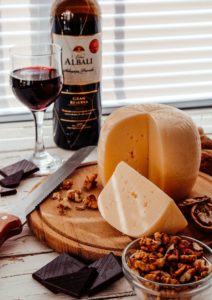

There’s been a lot of talk lately about the dangers of mycotoxins. Sadly, mycotoxins are often found in dried spices. It seems these toxic substances are not only invisible, but they are common in tasty favorites like wine, nuts, and dried herbs & spices. Ingesting large amounts of mycotoxins can cause severe illness, and in some cases death, so it is especially important to avoid them while healing from mold exposure/CIRS.
Reducing the quantity of food items that burden the body -causing inflammation and immune responses- will free up energy that can in turn be used to promote healing.
An easy place to start reducing mycotoxins is in your kitchen – specifically the place where all the dried spices are stored.

Do you own a spice graveyard? You know, the little jars, tins, and bags of spices & seasonings hibernating in a cabinet or drawer until a recipe calls for them? Perhaps there’s a collection above you stove that looks a bit grimy from all that splatters?
How long have you had this collection?…
Consider the items that don’t really have a noticeable aroma anymore and just look like a dry winter’s day? (or maybe look a little dusty like the fine powder in your vacuum cleaner? 😉 Are you guilty of thinking “They’re probably fine. I’ll buy some next time at the store, just using a pinch for tonight’s dinner…“
A little food for thought~
- If the seasoning is weak in scent- it’s probably next to worthless as a flavor enhancer. The longer it sits in storage, freshness and flavor dissipate. Not very tempting to the taste buds really. To compare: sniff freshly picked basil, then sniff that jar of dull green flakes.
- What about mycotoxins? These microscopic toxins love to grow in closed containers of organic matter that has been sitting around for a while and these organisms typically do not have a discernible flavor. Ready to chance it? Is the potential flavor of the spice in the container worth it?
When researching the longevity and toxicity of dried herbs & spices that we conveniently purchase at the supermarket, I discovered a common theme. Household spice brands (that fund the research?) claim that “Spices never expire” …a great marketing strategy- keep the company name in the customer’s line of sight .. forever. lol
Perhaps a more accurate description would be: “spices kept in ideal storage will probably not turn rancid and make you sick even after several years on the shelf” … somehow, this does not sound very appetizing!
Six reasons to switch to fresh herbs & spices right now:
- Dried spices and herbs will lose flavor and potency as they sit around in your spice collection, exposed to temperature changes, humidity, and light.
- The exceptional flavor of herbs like basil and mint is prominent in the water based moisture in the leaves rather than the oil. Drying the leaves removes the water and much of the flavor.
- Spice blends often contain additional ingredients that are not a spice or an herb- like anti caking agents.
- Color enhancers & fumigation are common in shelf stable herbs & spices on grocery store shelves.
- Expiration dates are not always accurate.
- Testing funded by the FDA show Mycotoxin contamination is common
For now, it’s best to avoid all the “extras’ ‘ that may come with “shelf stable” items. At least until you are fully healed from mold exposure~ consume only fresh, not wilty, not moldy, chemical-free foods.
Personally, I prefer the aroma and flavor of fresh seasonings. When you reach for herbs & spices, your senses should send good messages to your brain like: “mmmm! This scent is so fresh and savory!” … not “well, it doesn’t smell like much… but I guess it doesn’t smell rancid ”. Which would you rather taste on your food? Do your body and your tastebuds a favor – put aside the old dusty containers… try a few fresh herbs!
My foodie self aside, when healing from CIRS, it is best to avoid dried herbs & spices as much as possible. Often the contents of these jars & tins purchased from the supermarket came from places very far away. Typically transported from other countries where they grow well, cost less to produce, and regulations are less restrictive. These luscious growing territories are often humid, and the spices need to be stored until the grocery store shelves run low. This is an ideal environment for mycotoxins found in spices to thrive. Even though the container of spice may not “smell or look bad”, tests from all around the world show mycotoxins are common.
These additional toxins will further burdon your immune system, so please avoid them whenever you can and use fresh, unmoldy herbs and spices like the ones listed below.
Curiously, one dried spice – ceylon cinnamon (not cassia cinnamon) – repeatedly showed low or undetectable levels of mycotoxins in testing. Yay! Something delicious, healthy, and potentially free of toxins in my dried spice collection! I love buying mine at our local spice shop (and other items too!), as they take great care in packaging, storing, and rotating fresh stock. Most large grocery stores do not have the payroll or vendor support to take on tasks like this. And supporting local shops where the owner takes pride in a quality product is always good.
Recovering from mold illness will take every bit of energy your immune system has to offer; don’t give it something additional to battle right now.
This list of herbs & spices (aka: flavorings, seasonings) are acceptable for the CIRS/ Mold free diet when purchased and used fresh not dried.
They are full of flavor and strongly preferred over the dried versions from supermarkets, as dried or prepared versions often contain high levels of mycotoxins. Of course, avoid any food item- regardless of its form- if you have a reaction of any kind.
- Thyme
- Basil
- Oregano
- Parsely
- Cilantro/coriander
- Rosemary
- Dill
- Mint
- Sage
- Chives
- Tarragon
- Marjoram
- Ginger root
- Chervil
- Fennel
- Winter savory
- Lemongrass
- Garlic
- Turmeric
- Hot pepper
- Citrus zest
- Edible flowers- fresh not dried
- *cinnamon
- Salt
- Curry leaves (fresh)
TIP: grow a few of your favorites at home for a good ROI!
The spice shop I love and a coupon : https://www.savoryspiceshop.com/
If this post about mycotoxins from spices was of interest- please sign up fo the Free Monthly Newsletter!
- Free exclusive recipes
- Helpful product giveaways
- Latest news before it reaches the blog
- Supportive tips from the moldfreemenu community
Coming soon! Sign up to be one of the first to receive these:
- Free guide of CIRS approved spices, herbs, and flavorings
- List of the items that have the most and least mycotoxin levels.
- Easy recipes for beverages made with fresh herbs
- Free exclusive recipes
- Helpful product giveaways
- Latest news before it reaches the blog
- Supportive tips from the moldfreemenu community
Other posts you might be interested in:
Two most important First Steps in healing from mold illness
Definitions and important phrases related to CIRS
35 safe foods for CIRS and five to avoid completely
What is a Low Amylose diet and why follow it?
The best air purifiers for mold filtration
Share your low amylose reader recipes here!
According to Dr Shoemaker, the low amylose diet is a priority. Taking additional action like removing common inflammatory foods is entirely your decision to make. Some recipes may have ingredients that you don’t like or your body reacts to in some way. We recommend you avoid any food you negatively react to and substitute a different no-amylose food that does not create discomfort. Some common triggers to keep in mind are: nuts & seeds, dairy, and nightshades. Occasional consumption of some potentially inflammatory whole foods like healthy nuts & seeds, small amounts of egg, fresh vegetables & fruits that are considered nightshades might be tolerated by some people. Use caution and observe reactions to these foods carefully when challenging them after your elimination diet.
Always use fresh ingredients while healing from CIRS. NO dried, cured, canned, jarred, or pre packaged foods are recommended because of the potential for mycotoxins and unaccepted additives.
CIRS approved, moldfreemenu recipes will be low or free of amylose, and slant to AIP (Autoimmune Protocol Diet), Dairy Free/Gluten Free/Whole30/Low-carb, Paleo. The recipes will also not contain fungus, mold, or sugar. If any ingredient is unfavorable for you, omit it and potentially substitute something from the Mold Free Menu list of CIRS approved foods that is similar.
*NOTE: eggs are often not tolerated to some degree; causing an inflammatory response. Pay very close attention when reintroducing eggs on your elimination diet; most will need to eliminate eggs for the early stages of healing.
*NOTE: for those with pain, aching and myalgia, nightshades should be avoided.
*NOTE: nuts and seeds contain amylose, and might contain mycotoxins. Eat in moderation or avoid. If nuts and/or seeds are listed on moldfreemenu, they have been selected based on research that they are less likely to contain mycotoxins. ALWAYS store in a cool, dark, dry place.
*NOTE: Take considerable caution selecting fish & seafood, as many are likely to contain varying amounts of toxins & bacteria. Avoid especially in the early stages of healing or eat in moderation to minimize toxins. More info
A low amylose diet is beneficial for CIRS recovery according to Dr. Shoemaker. Elevated MMP9 levels can often be reduced by following a strict low or no amylose diet. Ask your health professional to monitor your bloodwork details.
Share this (Facebook, Pinterest, Instagram)
Spice is life. It depends upon what you like…have fun with it. Yes, food is serious, but you should have fun with it.
– Emeril Lagasse
The information we provide at Moldfreemenu.com is intended to provide information to better understand how a healthy diet is part of healing from biotoxin illness and not intended to replace consultation with a qualified medical professional.Specific medical advice including diagnosis and treatment will not be provided. This diet does not cure mold illness but does help reduce inflammation- thus reduce symptoms triggered by inflammation.
To read research done by https://www.ncbi.nlm.nih.gov/pubmed/26528824- the National Center for Biotechnology Information
The sad news about black pepper… https://www.sciencedirect.com/science/article/abs/pii/S0956713510001271 …. “frequently affected by Aspergillus spp. include chili peppers, black pepper, coriander, turmeric and ginger.” https://www.who.int/news-room/fact-sheets/detail/mycotoxins https://www.sciencedirect.com/science/article/pii/S2211601X16000663
